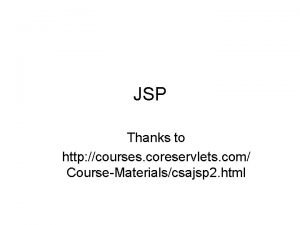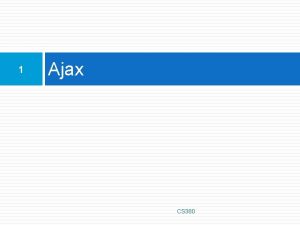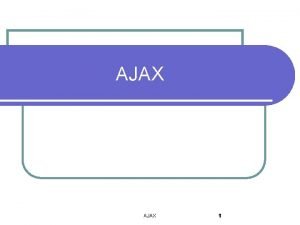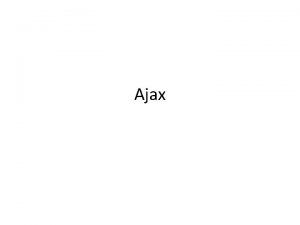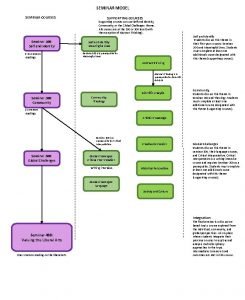AJAX http courses coreservlets com AJAX Way to























- Slides: 23

AJAX http: //courses. coreservlets. com

AJAX �Way to create interactive Web applications: �Eg. Click map and drag it in the direction you want and the map view moves as you drag �“No waiting” �User is “in control” �Allows for creation of Web-based apps with the kind of user experience found on a traditional desktop application �“Client side” oriented

Applications �Google �Gmail �Google calendar �Google Suggest �Google maps �Google mashups: googlemapsmania. blogspot. com �Yahoo! �My Yahoo! Portal �Yahoo! Front page �Yahoo! Mail

AJAX �Used to stand for: �Asynchronous Javascript And XML. �Now just the name �XML part may be done by � XML � JSON � Text �… �Not a new programming language �A new way to send and receive data between a web browser and a web server �Asynchronous means that the requests happen independent of other requests: �Makes web applications smaller and faster

AJAX �Main parts of AJAX: � (X)HTML (or servlets or PHP or…) � Displays web page content � CSS (Cascading style sheets) � Makes the web page “pretty” � The DOM (Document Object Model) Representation of objects within the document � Accessed using Java. Script (where main functionality lies) � XML (for data transfer): � XML is just a method of transferring data � � Any type of transfer, including plaintext or JSON, can be used � XMLHttp. Request to retrieve data from the server

AJAX �AJAX lets a web front end (html, JSP, servlets) make function calls to client side Java. Script �Java. Script, in turn, calls a server side application or script to return the desired results �Server side application can be php, perl, servlet, C++ or any server program

AJAX �Synchronous vs. Asynchronous �Traditional HTTP requests happen synchronously � Pages are loaded one at a time � A new request requires the browser to reload the returned webpage �AJAX allows these requests to be asynchronous � Allows new “requests” without having to reload entire web pages

AJAX Client Server Client Initial Request Browser Blocked Render Page Initial Request Browser Blocked Render Page update Page Non-AJAX Session http: //courses. coreservlets. com partial Interaction Render Page Interaction update Browser Blocked Server update partial AJAX Session

XMLHttp. Request Object �Java. Script has an object �The XMLHttp. Request object �This is the heart and soul of AJAX: �This object is responsible for the actual sending and receiving of data between client and server � Send method allows parameters to be sent to other web pages or scripts �Contains methods to receive data �Upon receiving data the Java. Script allows the data to be parsed and used

AJAX and XMLHttp. Request Object Can handle multiple Requests at a time (asynchronous) http: //www. javareference. com/jrexamples/printexample. jsp? id=111

XMLHttp. Reqeust Object �XMLHttp. Request methods: �open() � Sets up a request to a web server �send() � Sends a request to the server �abort() � Aborts the current server request

Creating XMLHttp. Request �Creating the XMLHttp. Request object depends on the browser type �Since you never know what browser a user is using � You have to check for each type �Microsoft uses an Active. XObject �Other browsers may use the standard XMLHttp. Request object

Creating �First create a variable XMLHttp to use as your XMLHttp. Request object: � Set the value to null � Try to create the object the Microsoft way: � Available � in IE 6 and later: XMLHttp=new Active. XObject("Msxml 2. XMLHTTP") � If this catches an error, try the older (Internet Explorer 5. 5) way: � XMLHttp=new Active. XObject("Microsoft. XMLHTTP") � If XMLHttp still has a null value, try to create the object the "standard" way: � XMLHttp=new XMLHttp. Request()

XMLHttp. Request Ready. State �Readystate �Allows the browser to stay informed of the current state of the request �Upon completion, the “onreadystatechange” property allows a function to be called to further process the returned data

XMLHttp. Reqest Ready. State Open() S 0 S 1 Send() Create XMLHttp. Request Object S 2 Established Communication w/ server S 3 S 4 Completed (HTTP 200)

XMLHttp. Request Ready. State � ready. State=0 � after creating the XMLHttp. Request object � before calling the open() method � ready. State=1 � after calling the open() method � before calling send() � ready. State=2 � after calling send() � ready. State=3 � after the browser has established a communication with the server � before the server has completed the response � ready. State=4 � after request has been completed � after all response data has been completely received from the server � the final state, similar to a HTTP 200

Callback Function �When readystate = 4 �onreadystatechange property allows the XMLHttp. Request object to call a function �This function is called the “callback function” �Java. Script can then obtain the returned data �Performs any type of processing that needs to be done on the data �Contain a check such as �if(XMLHttp. Request. ready. State == 4) �Checks the state for processing

Processing Data �Data can be returned in the form of: �Plaintext �XML �JSON �or any acceptable format �XMLHttp. Request has functions to handle various types: �XMLHttp. Request. response. Text � Returns the text in a “string” fashion �XMLHttp. Request. response. XML � Returns the XML data in parsable format �Xml. Http. Request. response. JSON � JSON parsable format

Parsing XML �When the XML is returned to the Java. Script �Java. Script does the parsing of the XML �Java. Script has access to the DOM �(Document Object Model) �With the DOM, you have access to elements �Can call them by tag name �Can get their value

Parsing XML �Example �Say we have the following XML: <customer> <store. ID>1234</store. ID> </customer> �If we wanted to get the value of the <store. ID> element we simply call it by its name � get. Elements. By. Tag. Name(”store. ID")[0]. child. Nodes[0]. node. Value � This will return the value of <store. ID>: 1234 � child. Nodes[0] is the first child. Node, in this example the only node, and that happens to be the value. � Therefore we can obtain the value “node. Value. ”

Pointers �Whitespace as XML Node �XML Specification states that it is whitespace preserving �Reading Node[0] will return the whitespace instead of the first node �<Node 1> <Node 2>Text</Node 2></Node 1> �Workarounds: �Remove whitespace �Programatically scan children when looking for specific nodes

Pointers �Location of Java. Script File �Should be placed in public_html or a web-accessible subfolder �Do not place in WEB-INF or a subfolder of WEB-INF

Pointers �Browser caching and browser issues �More difficult to debug �Browser caching may prevent some pages from reloading correctly � Refresh page or disable caching of the page �Browser versions and script interpreter versions may cause problems � Having multiple browsers and adjusting settings can alleviate problems.
 Cơm
Cơm Bài thơ mẹ đi làm từ sáng sớm
Bài thơ mẹ đi làm từ sáng sớm Coreservlets
Coreservlets Coreservlets
Coreservlets Coreservlets.com
Coreservlets.com Perbedaan anova one way and two way
Perbedaan anova one way and two way The old way and the new way
The old way and the new way One way table and two way table
One way table and two way table One-way anova hypothesis testing
One-way anova hypothesis testing The one was a ship
The one was a ship Perbedaan one way dan two way anova
Perbedaan one way dan two way anova One way anova vs two way anova
One way anova vs two way anova Walk this way talk this way
Walk this way talk this way Differentiate between binary tree and threaded binary tree
Differentiate between binary tree and threaded binary tree Contoh soal uji two way anova
Contoh soal uji two way anova Siat.ung.ac.id
Siat.ung.ac.id Http //mbs.meb.gov.tr/ http //www.alantercihleri.com
Http //mbs.meb.gov.tr/ http //www.alantercihleri.com Ajax updater
Ajax updater Lathe grinder attachment
Lathe grinder attachment Ajax scales
Ajax scales Slideshare
Slideshare Ajax vs wsb
Ajax vs wsb Microsoft ajax content delivery network
Microsoft ajax content delivery network Ajax asynchronous javascript and xml
Ajax asynchronous javascript and xml




